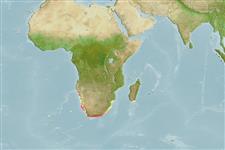Common names from other countries
>
Perciformes/Scorpaenoidei (Scorpionfishes) >
Triglidae (Searobins) > Triglinae
Etymology: Chelidonichthys: Greek, chelidon, -onos = swift, as black as a swift + Greek, ichthys = fish (Ref. 45335).
More on author: Regan.
Environment: milieu / climate zone / depth range / distribution range
Ecologia
marinhas demersal; intervalo de profundidade 0 - 150 m (Ref. 4316). Subtropical; 20°S - 35°S
Western Indian Ocean: southern Mozambique southward to Table Bay, South Africa.
Comprimento de primeira maturação / Tamanho / Peso / Idade
Maturity: Lm 19.5 range ? - ? cm
Max length : 35.0 cm TL macho/indeterminado; (Ref. 4316); idade máx. registrada: 7 anos (Ref. 26321)
Descrição suscinta
Chaves de identificação | Morfologia | Morfometria
Espinhos dorsais (total) : 9; Raios dorsais (total) : 18 - 19; Espinhos anais: 0; Raios anais : 17 - 18.
Found in shallow water to 150 m depth (Ref. 27121).
Ciclo de vida ou comportamento de acasalamento
Maturities | Reprodução | Spawnings | Egg(s) | Fecundities | Larvas
Heemstra, P.C., 1986. Triglidae. p. 486-488. In M.M. Smith and P.C. Heemstra (eds.) Smiths' sea fishes. Springer-Verlag, Berlin. (Ref. 4316)
Status na Lista Vermelha da UICN (Ref. 130435)
CITES (Ref. 128078)
Not Evaluated
Ameaça para os humanos
Harmless
Uso pelos humanos
Pescarias: pouco comercial
Ferramentas
Relatórios especiais
Baixar XML
Fontes da internet
Estimates based on models
Preferred temperature (Ref.
115969): 13.7 - 24.5, mean 16.7 (based on 72 cells).
Índice de diversidade filogenética (Ref.
82804): PD
50 = 0.5010 [Uniqueness, from 0.5 = low to 2.0 = high].
Bayesian length-weight: a=0.02291 (0.01339 - 0.03920), b=3.21 (3.06 - 3.36), in cm Total Length, based on LWR estimates for this species & (Sub)family-body (Ref.
93245).
Nível Trófico (Ref.
69278): 3.8 ±0.3 se; based on diet studies.
Resiliência (Ref.
120179): médio(a), tempo mínimo de duplicação da população 1,4 - 4,4 anos (K=0.38-0.59; tm=1.7; tmax=7).
Fishing Vulnerability (Ref.
59153): Low vulnerability (25 of 100).
